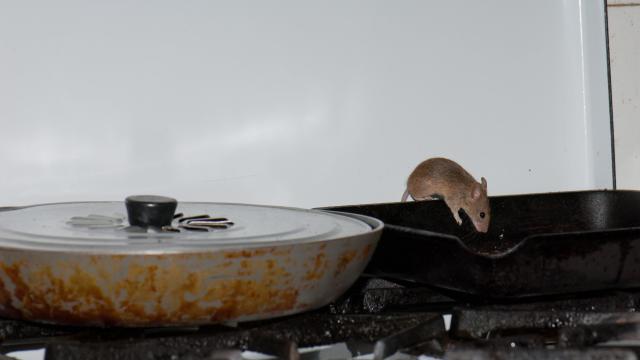If you find yourself unwillingly hosting scratchy, scurrying vermin in your kitchen — and you’re pretty sure you hear them rattling around in your stove and oven — you’re not alone. Mice are attracted to the warmth of the pilot light and plentiful crumbs and leftover food scraps in and around your oven. Here’s how you can get rid of them.
First, clean in and around your stove
Mice flock to ovens and stoves for the free grub, so the first step is to starve them out. Scrub the inside of your stove, ridding it of any food debris. Sweep the floor, keeping it crumb-free and seal up any open food sources, including garbage bags. Check your floors and stove daily to prevent build-up.
Turn off the gas and pull out your stove
In order to thoroughly check behind your oven, you’ll need to pull it away from the wall. And in order to do that, if it’s gas-powered, you’ll need to first turn off the gas valve so you can disconnect the gas intake hose from the oven.
Pull the stove away from the wall to determine how the mice are getting in. Sometimes, you’ll find an obvious mouse-sized hole as the culprit (which could be as small as a dime); other times, your clues will be scratch marks or mouse droppings. Check behind sinks, near pipes and around one of the most common entryways — your stove’s gas intake hose.
Seal the entry points to your oven
While Terminix suggests sealing up these entry points with caulk or wire mesh, another approach is to stuff the holes with cotton balls soaked in pure peppermint oil, followed by steel wool, before sealing the hole with spackling paste for an extra layer of protection. Then cover the area with cardboard so mice won’t disturb your handiwork while it dries — and the fateful moment they inevitably try to hightail it out of the oven.
Set your traps, and then…do worse
Here’s where the two mouse-capturing roads diverge. While Terminix says to seal all holes, set snap traps behind the oven, and re-bait them frequently (then call them to finish the job if that doesn’t work), this Hunker article takes it a potentially gruesome step further. In it, they suggest placing glue traps or snap traps baited with peanut butter or cheese around entry points and along the back wall of your oven, which seems normal enough. (If you don’t want to trap them in glue, you can also use no-kill traps.) But there’s more.
After reconnecting the gas line and turning the valve back on, you could deliver the coup de grace by turning on the oven (and broiler if you’re hardcore), and the heat will force the mice out of any remaining holes you didn’t see, and get caught in the traps.
“Follow any escaping mice that make it past the glue traps to any more mouse holes you may not know of,” they advise. But…what if you can’t see where they exited from, much less follow them fast enough? And the more disturbing inquiry: What if you sealed all the holes and there are no more from which they can escape? What then? What do I do with mass mice murder on my conscience?
If the idea of removing singed mice corpses from your oven gives you a shiver, there is another path, suggested by my humane husband who repeatedly asked, “Why are you writing about this again?” Which, honestly, fair question.
If you don’t want to play mouse detective or take the chance that you haven’t left any escape holes, leave one open on purpose. That way, when you turn on the heat, the mice will have at least one sure way to escape. Place your traps behind that exit point. Or, if your problem is bad enough and you’re willing to spend the money, call a professional exterminator to take care of the problem for you.

Leave a Reply
You must be logged in to post a comment.